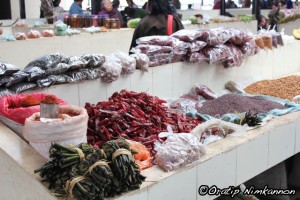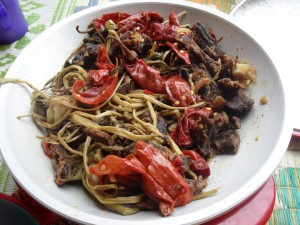If there’s one typical thing for Bhutanese cuisine, it’s that the Bhutanese love it spicy! Chilies are not considered a seasoning, but a true valuable vegetable. Therefore traditional Bhutanese food is lavishly spiced with dried or fresh red and green chilies. Which is exactly why, while in Bhutan you ought to try the national dish of Ema Datshi, shown on the image above, consisting of Ema (chilli) cooked in Datsi (cheese). This recipe has spun into numerous variations: Kewa Datsi (potato and cheese), Shamu Datsi (mushroom and cheese). These would be the standard fare in most Bhutanese restaurants, but do tell them how hot, that is how much chili you can take in your meal.
Red rice, which is extremely nutritious and similar to brown rice, forms the main chunk of most meals in Bhutan. It is pale pink, soft, and slightly sticky after cooking, and comes along with one or two side dishes containing meat or vegetables. Pork, beef and chicken are eaten regularly, while commonly eaten vegetables include spinach, pumpkins, turnips, radishes, tomatoes, riverweed, onions and green beans. Nevertheless, buckwheat pancakes and noodles replace rice as the favorite staple in Bumthang.





